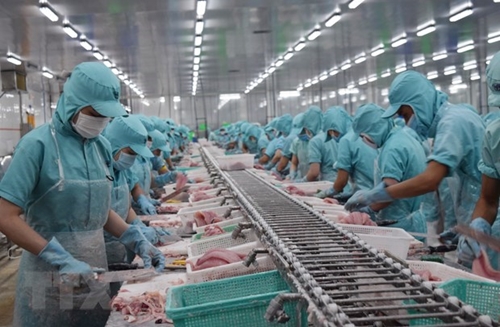Major farm produce fetched nearly 1.47 billion USD, down 14.7 percent, forestry products about 683 million USD, down 24 percent, and fisheries products 563 million USD, down 10.8 percent.
    |
 |
|
Processing fish for exports. (Photo for illustration) |
In the first four months of the year, total exports and imports of agro-forestry-fisheries was estimated at around 21.1 billion USD, 11.9 billion USD of which was from exports, down 4.9 percent year-on-year. Imports were down 5.2 percent. A trade surplus of about 2.8 billion USD was posted, down 4.1 percent against the same period last year.
Most exports saw declining revenue, except coffee, cashew nuts, vegetables, wood and wooden furniture, cinnamon, and bamboo products.
China remained the largest importer of Vietnamese agro-foresty-fisheries products, with a value of nearly 2.8 billion USD, down 17.7 percent and accounting for a market share of 23.4 percent. Following was the US, with 2.78 billion USD, down some 14 percent with a share of 23 percent, and the EU with 1.3 billion USD, down some 2 percent with a share of 11 percent.
Agro-forestry-fisheries exports to several markets saw slight increases, such as Japan, up around 3 percent to nearly 1.1 billion USD for a market share of 9 percent, and ASEAN, up 7 percent to about 1.3 billion USD for a market share of 11 percent.
Amid the complex environment created by COVID-19, MARD will work with the Ministry of Industry and Trade, agencies, and businesses to closely monitor price movements and supply and demand for key farm produce such as rice, pork, vegetables, aquatic products, sugar, and salt, to ensure domestic food security and maintain exports.
MARD will also deal with technical barriers and step up negotiations to expand markets to the EU, the Eurasian Economic Union, the US, Brazil, and Saudi Arabia, as well as plan working trips to China, Russia, Japan, and Australia.
In order to boost trade with China amid the pandemic, Minister of Agriculture and Rural Development Nguyen Xuan Cuong suggested continuing to accelerate agriculture restructuring via production chains and processing.
While cooking oil, wheat, and rubber rose, he said, fertilizer, pesticides, animal feed, fruit and vegetables posted declining import values.
Source: VNA